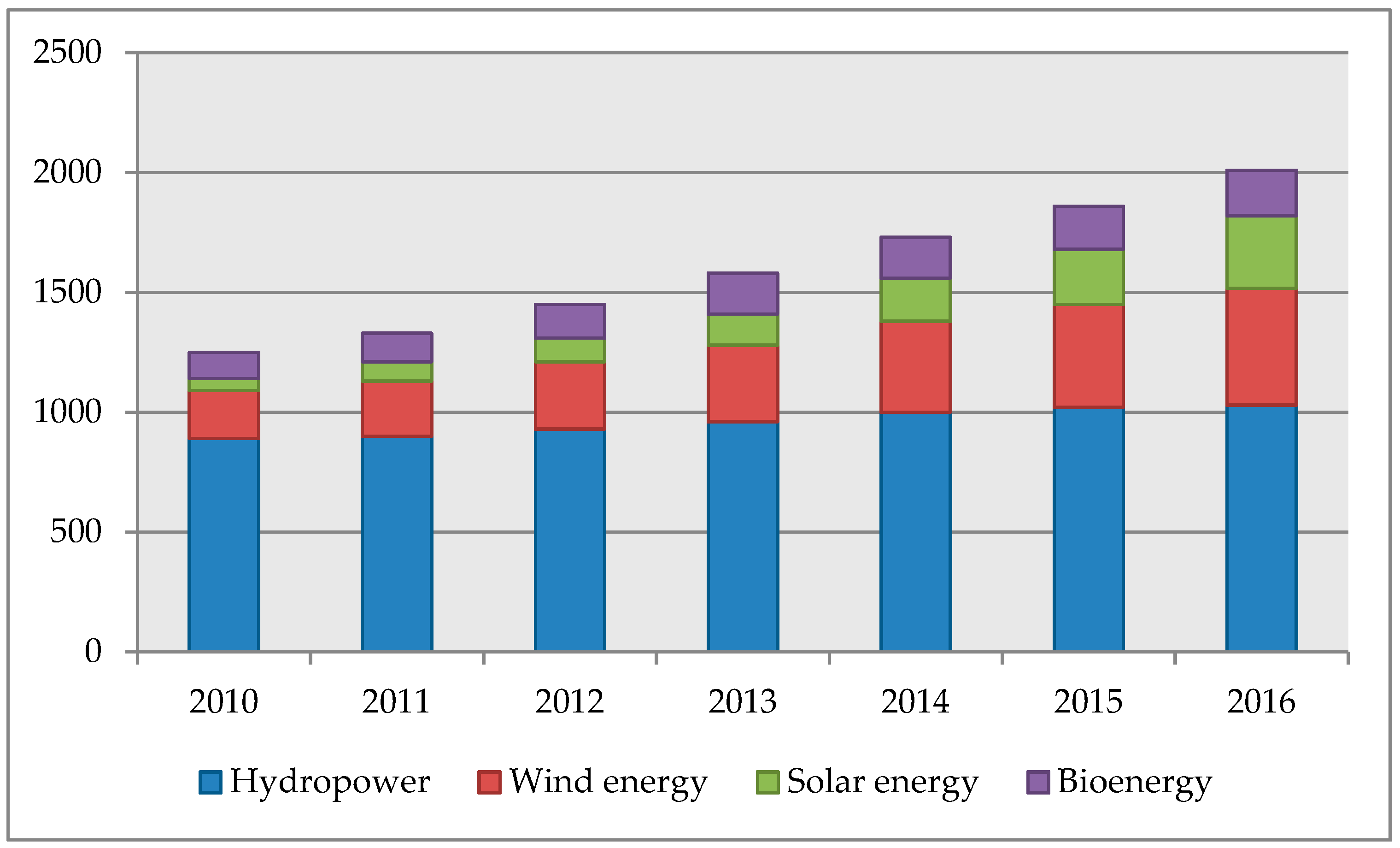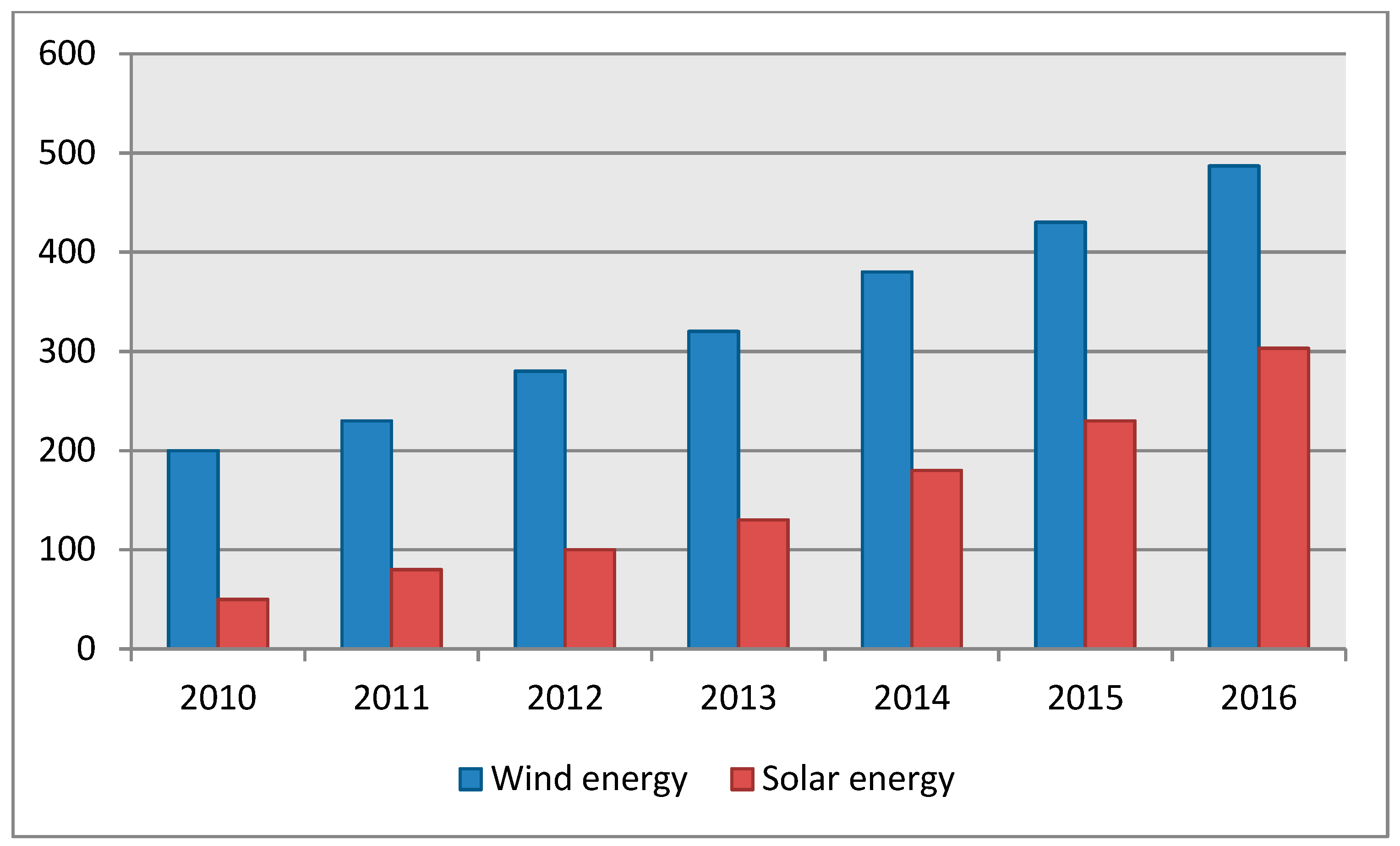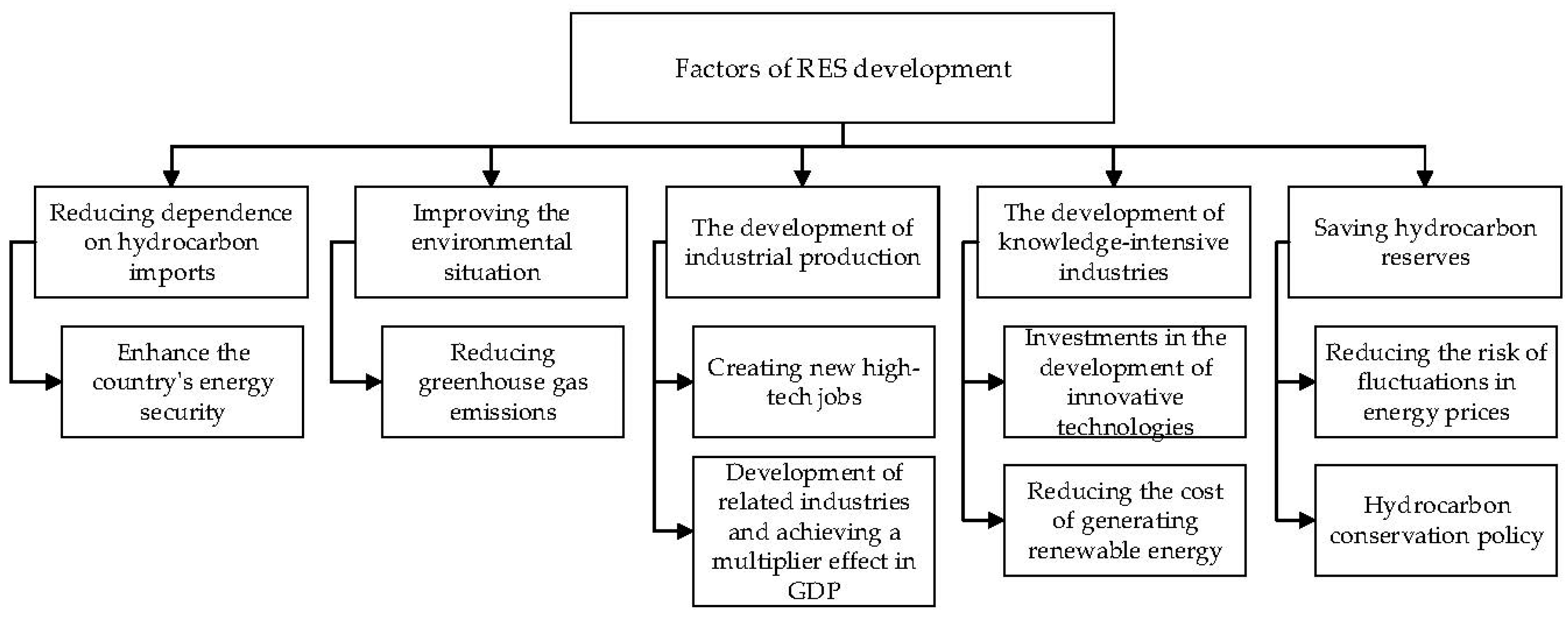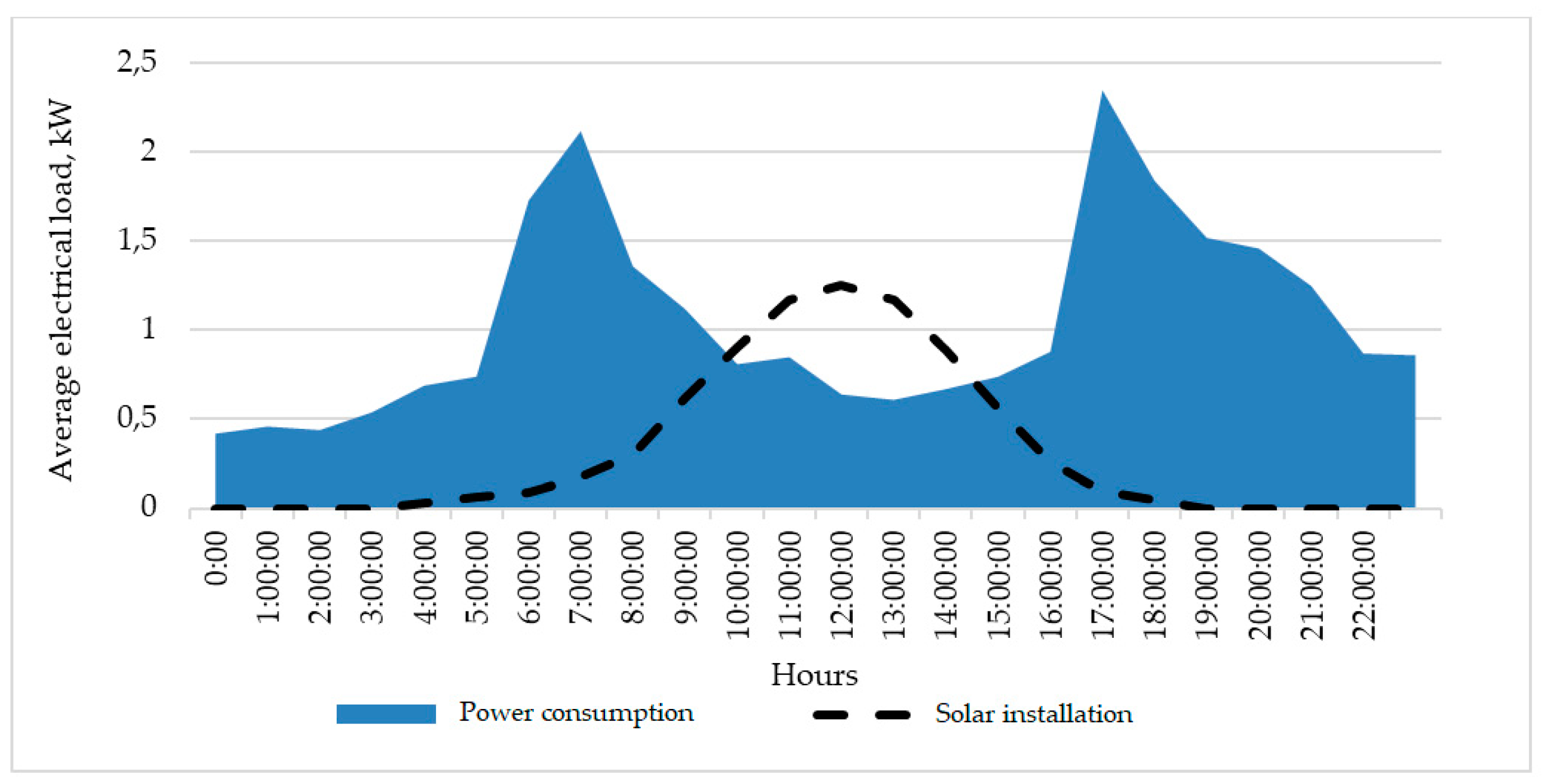Efficient Methods of Market Pricing in Power Industry within the Context of System Integration of Renewable Energy Sources
Abstract
1. Introduction
- Inconsistency between the existing systems for differentiating electricity tariffs by time zones and real daily energy consumption schedules which leads to inefficiency of the tariff policy in the field of energy management of consumers and their irrational use of renewable energy sources.
- The need to reduce the growth in the cost of electricity for consumers from the power supply system caused by suboptimal loading of the production capacity of the energy system when consumers use autonomous energy sources based on renewable energy sources.
- Stimulating consumers to align the schedule of electricity consumption during the day and increase the efficiency of using autonomous energy sources based on renewable energy sources (RES), including the use of electric energy storage technology.
2. Overview of the Global Renewable Energy Market
3. Analysis of the Methods and Consequences of State Support for the Development of RES
- decarbonization of power systems and an increase in domestic electricity production,
- improving the technological competitiveness of renewable energy by reducing production costs and creating new jobs.
- In some countries, state programs of support for renewable energy have existed for more than 20 years, which made it possible to analyze the experience of the best practices in implementing such programs. There are four categories of government policy tools to support renewables:
- tax incentives;
- state subsidies;
- regulatory tools;
- privileged access policy.
4. Proposal for the Method of Dynamic Differentiation of Electricity Tariffs
- Based on the statistical analysis of data for the previous period, daily graphs of consumer load are compiled on a typical work day and a day off: и
- According to consumer load schedules, values are calculated:
- Minimum power consumption per unit of time:
- Average power consumption per unit of time:
- Half-peak power consumption per unit of time:
- Maximum power consumption per unit of time:
- Energy consumption zones are determined:
- Basic power consumption (B):
- Half-peak power consumption (PP):
- Peak power consumption (P):
- A fixed tariff rate is established for the base consumption zone, and an interval of tariff rates is established for the half-peak and peak power consumption zones:
- Basic power consumption (B):
- Half-peak power consumption (PP):
- Peak power consumption (P):
- We believe that the increase or decrease in energy consumption proportionally reduces or increases the cost of electricity in the corresponding zone with the coefficient :
- Half-peak power consumption (PP):
- Peak power consumption (P):
- The chain growth rates are calculated, which characterize the increments of energy consumption in the areas of half-peak and peak consumption:
- Half-peak power consumption (PP):
- Peak power consumption (P):
- A dynamic calculation of the cost of electricity for the consumers at each time point for working days and days off are produced. In case of increase in energy consumption in the half-peak and peak zones, an additional penalty is imposed . Accordingly, when energy consumption decreases in comparison with the previously registered value, the tariff rate is decreased:
- The total cost of electricity per day is calculated, taking into account the discrete values of the indications of smart meters:
5. Empirical Model: A Case Study of Krasnodar Region of Russia
6. Conclusions
Author Contributions
Funding
Acknowledgments
Conflicts of Interest
Nomenclature
| A List of Symbols | |
| daily graphs of consumer load on a typical work day and a day off | |
| minimum power consumption on a typical work day and a day off | |
| average power consumption on a typical work day and a day off | |
| half-peak power consumption on a typical work day and a day off | |
| maximum power consumption on a typical work day and a day off | |
| fixed tariff rate for the basic power consumption zone | |
| interval of tariff rates for the half-peak power consumption zone | |
| interval of tariff rates for the peak power consumption zone | |
| cast coefficient for the half-peak power consumption zone | |
| cast coefficient for the peak power consumption zone | |
| chain growth rates for the half-peak power consumption zone | |
| chain growth rates for the peak power consumption zone | |
| tariff rates at each time point for working days and days off | |
| total cost of electricity per day for working days and days off | |
| Abbreviations | |
| RES | renewable energy sources |
| B | basic power consumption zone |
| P | peak power consumption zone |
| PP | half-peak power consumption zone |
References
- Melas, V.; Lisin, E.; Tvaronavičienė, M.; Peresadko, G.; Radwański, R. Energy security and economic development: Renewables and the integration of energy systems. J. Secur. Sustain. Issues 2017, 7, 133–139. [Google Scholar] [CrossRef]
- Augutis, J.; Martišauskas, L.; Krikštolaitis, R.; Augutienė, E. Impact of the Renewable Energy Sources on the Energy Security. Energy Procedia 2014, 61, 945–948. [Google Scholar] [CrossRef]
- Bhattacharya, M.; Paramati, S.; Ozturk, I.; Bhattacharya, S. The effect of renewable energy consumption on economic growth: Evidence from top 38 countries. Appl. Energy 2016, 162, 733–741. [Google Scholar] [CrossRef]
- Umbach, F. Global energy security and the implications for the EU. Energy Policy 2010, 38, 1229–1240. [Google Scholar] [CrossRef]
- Qureshi, M.; Rasli, A.; Zaman, K. Energy crisis, greenhouse gas emissions and sectoral growth reforms: Repairing the fabricated mosaic. J. Clean. Prod. 2016, 112, 3657–3666. [Google Scholar] [CrossRef]
- Uz, D. Energy efficiency investments in small and medium sized manufacturing firms: The case of California energy crisis. Energy Econ. 2018, 70, 421–428. [Google Scholar] [CrossRef]
- Ang, B.; Choong, W.; Ng, T. Energy security: Definitions, dimensions and indexes. Renew. Sustain. Energy Rev. 2015, 42, 1077–1093. [Google Scholar] [CrossRef]
- Filipović, S.; Radovanović, M.; Golušin, V. Macroeconomic and political aspects of energy security—Exploratory data analysis. Renew. Sustain. Energy Rev. 2018, 97, 428–435. [Google Scholar] [CrossRef]
- Sovacool, B. Differing cultures of energy security: An international comparison of public perceptions. Renew. Sustain. Energy Rev. 2016, 55, 811–822. [Google Scholar] [CrossRef]
- Abdmouleh, Z.; Alammari, R.; Gastli, A. Review of policies encouraging renewable energy integration & best practices. Renew. Sustain. Energy Rev. 2015, 45, 249–262. [Google Scholar] [CrossRef]
- Oree, V.; Hassen, S.; Fleming, P. Generation expansion planning optimisation with renewable energy integration: A review. Renew. Sustain. Energy Rev. 2017, 69, 790–803. [Google Scholar] [CrossRef]
- Radovanović, M.; Filipović, S.; Pavlović, D. Energy security measurement-A sustainable approach. Renew. Sustain. Energy Rev. 2017, 68, 1020–1032. [Google Scholar] [CrossRef]
- Maheshwari, Z.; Ramakumar, R. Smart integrated renewable energy systems (SIRES): A novel approach for sustainable development. Energies 2017, 10, 1145. [Google Scholar] [CrossRef]
- Simshauser, P. Distribution network prices and solar PV: Resolving rate instability and wealth transfers through demand tariffs. Energy Econ. 2016, 54, 108–122. [Google Scholar] [CrossRef]
- Strielkowski, W.; Štreimikienė, D.; Bilan, Y. Network charging and residential tariffs: A case of household photovoltaics in the United Kingdom. Renew. Sustain. Energy Rev. 2017, 77, 461–473. [Google Scholar] [CrossRef]
- Ntanos, S.; Kyriakopoulos, G.; Chalikias, M.; Arabatzis, G.; Skordoulis, M. Public perceptions and willingness to pay for renewable energy: A case study from Greece. Sustainability 2018, 10, 687. [Google Scholar] [CrossRef]
- Caldés, N.; del Río, P.; Lechón, Y.; Gerbeti, A. Renewable Energy Cooperation in Europe: What Next? Drivers and Barriers to the Use of Cooperation Mechanisms. Energies 2018, 12, 70. [Google Scholar] [CrossRef]
- Ntanos, S.; Skordoulis, M.; Kyriakopoulos, G.; Arabatzis, G.; Chalikias, M.; Galatsidas, S.; Katsarou, A. Renewable energy and economic growth: Evidence from European countries. Sustainability 2018, 10, 2626. [Google Scholar] [CrossRef]
- Noailly, J.; Smeets, R. Directing technical change from fossil-fuel to renewable energy innovation: An application using firm-level patent data. J. Environ. Econ. Manag. 2015, 72, 15–37. [Google Scholar] [CrossRef]
- Cucchiella, F.; D’Adamo, I.; Gastaldi, M. Future trajectories of renewable energy consumption in the European Union. Resources 2018, 7, 10. [Google Scholar] [CrossRef]
- Kim, K.; Kim, Y. Role of policy in innovation and international trade of renewable energy technology: Empirical study of solar PV and wind power technology. Renew. Sustain. Energy Rev. 2015, 44, 717–727. [Google Scholar] [CrossRef]
- Brecl, K.; Topič, M. Photovoltaics (PV) System Energy Forecast on the Basis of the Local Weather Forecast: Problems, Uncertainties and Solutions. Energies 2018, 11, 1143. [Google Scholar] [CrossRef]
- Kammen, D.; Sunter, D. City-integrated renewable energy for urban sustainability. Science 2016, 352, 922–928. [Google Scholar] [CrossRef] [PubMed]
- International Energy Agency. Statistics Data Browser. Available online: https://www.iea.org/statistics (accessed on 20 June 2019).
- BP Statistical Review of World Energy. 2018. Available online: https://www.bp.com/content/dam/bp/business-sites/en/global/corporate/pdfs/energy-economics/statistical-review/bp-stats-review-2018-full-report.pdf (accessed on 20 June 2019).
- Global Energy Statistical Yearbook 2019. Available online: https://yearbook.enerdata.net/renewables/renewable-in-electricity-production-share.html (accessed on 20 June 2019).
- International Energy Agency. Renewables 2017. Available online: https://www.iea.org/renewables2017 (accessed on 20 June 2019).
- International Renewable Energy Agency. Available online: https://www.irena.org/-/media/Files/IRENA/Agency/Publication/2018/Jan/IRENA_2017_Power_Costs_2018.pdf (accessed on 20 June 2019).
- University of Oxford. Our World in Data. Renewable Energy. Available online: https://ourworldindata.org/renewable-energy (accessed on 20 June 2019).
- Sander, M. Conceptual proposals for measuring the impact of international regimes on energy security. Energy Policy 2013, 63, 449–457. [Google Scholar] [CrossRef]
- Li, Y.; Shi, X.; Yao, L. Evaluating energy security of resource-poor economies: A modified principle component analysis approach. Energy Econ. 2016, 58, 211–221. [Google Scholar] [CrossRef]
- Löschel, A.; Moslener, U.; Rübbelke, D.T. Indicators of energy security in industrialised countries. Energy Policy 2010, 38, 1665–1671. [Google Scholar] [CrossRef]
- Proskuryakova, L. Energy technology foresight in emerging economies. Technol. Forecast. Soc. Chang. 2017, 119, 205–210. [Google Scholar] [CrossRef]
- Hoffmann, C. Beyond the resource curse and pipeline conspiracies: Energy as a social relation in the middle east. Energy Res. Soc. Sci. 2018, 41, 39–47. [Google Scholar] [CrossRef]
- European Commission. 2030 Climate & Energy Framework. Available online: https://ec.europa.eu/clima/policies/strategies/2030_en (accessed on 20 June 2019).
- Lisin, E.; Rogalev, A.; Strielkowski, W.; Komarov, I. Sustainable modernization of the Russian power utilities industry. Sustainability 2015, 7, 11378–11400. [Google Scholar] [CrossRef]
- Lisin, E.; Strielkowski, W. Modelling new economic approaches for the wholesale energy markets in Russia and the EU. Transform. Bus. Econ. 2014, 13, 566–580. [Google Scholar]
- Strielkowski, W.; Lisin, E.; Tvaronavičienė, M. Towards energy security: Sustainable development of electrical energy storage. J. Secur. Sustain. Issues 2016, 6, 235–244. [Google Scholar] [CrossRef]
- Ćetković, S.; Buzogány, A. Varieties of capitalism and clean energy transitions in the European Union: When renewable energy hits different economic logics. Clim. Policy 2016, 16, 642–657. [Google Scholar] [CrossRef]
- Ringel, M. Energy efficiency policy governance in a multi-level administration structure - Evidence from Germany. Energy Effic. 2017, 10, 753–776. [Google Scholar] [CrossRef]
- Kasmaei, M.P.; Lehtonen, M.; Sanz, J.C.; Mantovani, J.R.S. Carbon Footprint Management: A Pathway toward Smart Emission Abatement. IEEE Trans. Ind. Inform. 2019. [Google Scholar] [CrossRef]
- Cerna, F.V.; Pourakbari-Kasmaei, M.; Contreras, J.; Gallego, L.A. Optimal Selection of Navigation Modes of HEVs Considering CO2 Emissions Reduction. IEEE Trans. Veh. Technol. 2019, 68, 2196–2206. [Google Scholar] [CrossRef]
- The Renewable Energy Policy Network of the 21st Century (REN21). Renewables 2016. Available online: https://www.ren21.net/wp-content/uploads/2019/05/REN21_GSR2016_FullReport_en_11.pdf (accessed on 20 June 2019).
- Salas-Fumás, V.; Rosell-Martínez, J.; Delgado-Gómez, M. Capacity, investment and market power in the economic value of energy firms. Energy Econ. 2016, 53, 28–39. [Google Scholar] [CrossRef]
- Amrouche, S.; Rekioua, D.; Rekioua, T.; Bacha, S. Overview of energy storage in renewable energy systems. Int. J. Hydrog. Energy 2016, 41, 20914–20927. [Google Scholar] [CrossRef]
- Lisin, E.; Kindra, V.; Horvathova, Z. Sustainable development of regional heat supply systems in the context of the Eurasian economic union energy markets association. J. Secur. Sustain. Issues 2017, 6, 215–245. [Google Scholar] [CrossRef]
- McPherson, M.; Tahseen, S. Deploying storage assets to facilitate variable renewable energy integration: The impacts of grid flexibility, renewable penetration, and market structure. Energy 2018, 145, 856–870. [Google Scholar] [CrossRef]
- Lisin, E.; Shuvalova, D.; Volkova, I.; Strielkowski, W. Sustainable Development of Regional Power Systems and the Consumption of Electric Energy. Sustainability 2018, 10, 1111. [Google Scholar] [CrossRef]
- Lisin, E.; Sobolev, A.; Strielkowski, W.; Garanin, I. Thermal efficiency of cogeneration units with multi-stage reheating for Russian municipal heating systems. Energies 2016, 9, 269. [Google Scholar] [CrossRef]
- Jokar, P.; Arianpoo, N.; Leung, V.C. A survey on security issues in smart grids. Secur. Commun. Netw. 2016, 9, 262–273. [Google Scholar] [CrossRef]
- Dincer, I.; Acar, C. Smart energy systems for a sustainable future. Appl. Energy 2017, 194, 225–235. [Google Scholar] [CrossRef]
- Cucchiella, F.; D’Adamo, I.; Gastaldi, M. Economic analysis of a photovoltaic system: A resource for residential households. Energies 2017, 10, 814. [Google Scholar] [CrossRef]
- Daus, Y.; Kharchenko, V.; Yudaev, I. Evaluation of solar radiation intensity for the territory of the Southern Federal District of Russia when designing microgrids based on renewable energy sources. Appl. Sol. Energy 2016, 52, 151–156. [Google Scholar] [CrossRef]
- Smeets, N. Similar goals, divergent motives. The enabling and constraining factors of Russia’s capacity-based renewable energy support scheme. Energy Policy 2017, 101, 138–149. [Google Scholar] [CrossRef]
- Federal State Statistics Service. Main Statistics. 2018. Available online: http://www.gks.ru/wps/wcm/connect/rosstat_main/rosstat/ru/statistics (accessed on 20 June 2019).
- System Operator UES. Report on the functioning of the UES of Russia in 2017. Available online: https://so-ups.ru/fileadmin/files/company/reports/disclosure/2018/ups_rep2017.pdf (accessed on 20 June 2019).
- Kozlova, M.; Collan, M. Modeling the effects of the new Russian capacity mechanism on renewable energy investments. Energy Policy 2016, 95, 350–360. [Google Scholar] [CrossRef]
- Vasileva, E.; Viljainen, S.; Sulamaa, P.; Kuleshov, D. RES support in Russia: Impact on capacity and electricity market prices. Renew. Energy 2015, 76, 82–90. [Google Scholar] [CrossRef]
- PJSC “Kubanenergo”. Annual Report. 2017. Available online: http://kubanenergo.ru/media/media/kuban_web_oneside%2005-06.pdf (accessed on 20 June 2019).
- Faessler, B.; Schuler, M.; Preißinger, M.; Kepplinger, P. Battery storage systems as grid-balancing measure in low-voltage distribution grids with distributed generation. Energies 2017, 10, 2161. [Google Scholar] [CrossRef]
- Subramani, G.; Ramachandaramurthy, V.K.; Padmanaban, S.; Mihet-Popa, L.; Blaabjerg, F.; Guerrero, J.M. Grid-tied photovoltaic and battery storage systems with Malaysian electricity tariff—A review on maximum demand shaving. Energies 2017, 10, 1884. [Google Scholar] [CrossRef]







| Instruments of State Support for RES | 2005 | 2016 |
|---|---|---|
| Countries with approved state programs for the development of RES | 48 | 160 |
| Countries applying special tariffs for generating renewable energy | 34 | 108 |
| Countries using emission quotas for greenhouse gases | 11 | 99 |
| Category | One-Rate Tariff, Rubles/kWh | One-Rate Tariff, Differentiated by Two Zones of the Day, Rubles/kWh | One-Rate Tariff, Differentiated by Three Zones of the Day, Rubles/kWh | |||
|---|---|---|---|---|---|---|
| Day Zone (Peak and Half-Peak) | Night Zone | Peak Zone | Half-Peak Zone | Night Zone | ||
| for the amount of electricity consumed up to 250 kWh per month | 1.10 | 1.10 | 0.77 | 1.65 | 1.10 | 0.44 |
| for the amount of electricity consumed from 250 to 600 kWh per month | 1.44 | 1.44 | 1.01 | 2.16 | 1.44 | 0.58 |
| for the amount of electricity consumed in excess of 600 kWh per month | 4.95 | 4.95 | 3.47 | 7.43 | 4.95 | 1.98 |
| Types of Power Grid Tariffs | The Cost of Electricity for Households, Rubles/month | ||
|---|---|---|---|
| with Consumption only from the Power Grid | with Solar Installations | with Solar Installations and Storage | |
| One-rate tariff | 204,496 | 106,756 | 88,515 |
| One-rate tariff, differentiated by two zones of the day | 235,367 | 126,757 | 96,784 |
| One-rate tariff, differentiated by three zones of the day | 221,299 | 118,334 | 90,327 |
| “Dynamic” differentiated tariff | 220,157 | 98,245 | 73,346 |
© 2019 by the authors. Licensee MDPI, Basel, Switzerland. This article is an open access article distributed under the terms and conditions of the Creative Commons Attribution (CC BY) license (http://creativecommons.org/licenses/by/4.0/).
Share and Cite
Lisin, E.; Kurdiukova, G.; Okley, P.; Chernova, V. Efficient Methods of Market Pricing in Power Industry within the Context of System Integration of Renewable Energy Sources. Energies 2019, 12, 3250. https://doi.org/10.3390/en12173250
Lisin E, Kurdiukova G, Okley P, Chernova V. Efficient Methods of Market Pricing in Power Industry within the Context of System Integration of Renewable Energy Sources. Energies. 2019; 12(17):3250. https://doi.org/10.3390/en12173250
Chicago/Turabian StyleLisin, Evgeny, Galina Kurdiukova, Pavel Okley, and Veronika Chernova. 2019. "Efficient Methods of Market Pricing in Power Industry within the Context of System Integration of Renewable Energy Sources" Energies 12, no. 17: 3250. https://doi.org/10.3390/en12173250
APA StyleLisin, E., Kurdiukova, G., Okley, P., & Chernova, V. (2019). Efficient Methods of Market Pricing in Power Industry within the Context of System Integration of Renewable Energy Sources. Energies, 12(17), 3250. https://doi.org/10.3390/en12173250




